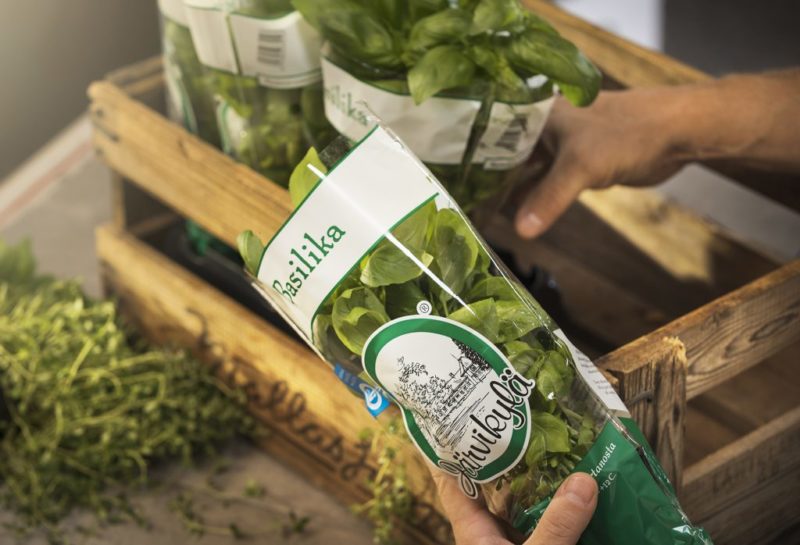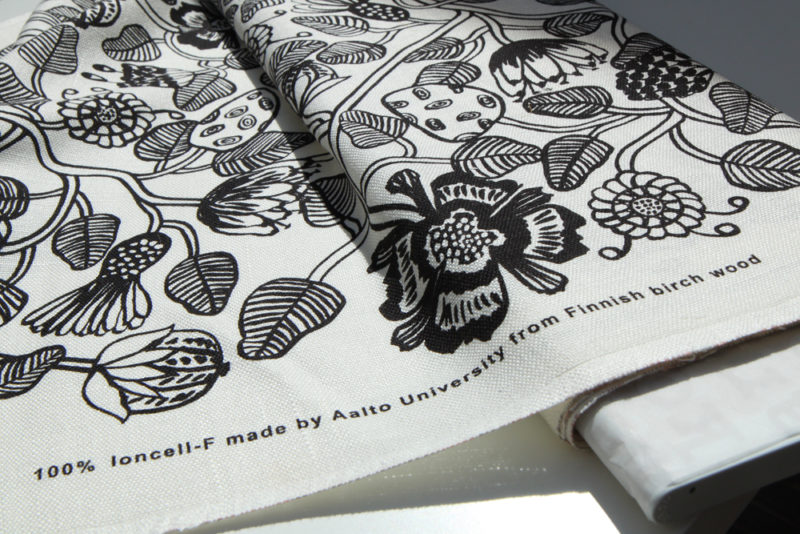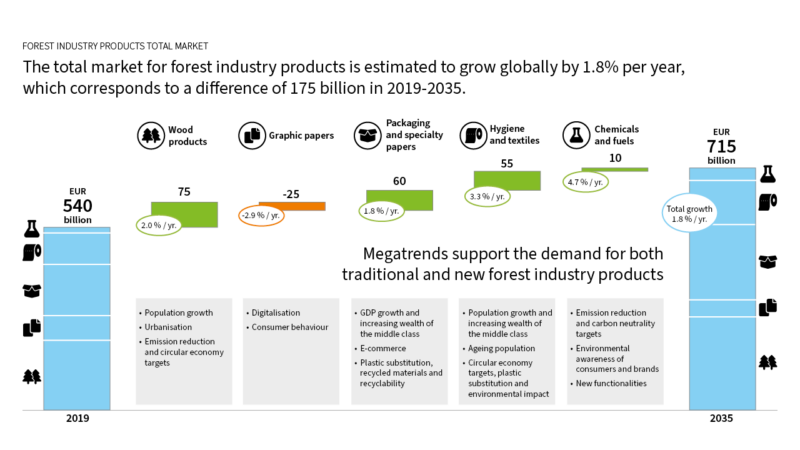
The global demand for wood products is predicted to increase by a third by 2035, reaching EUR 715 thousand million.
A recent report says that in terms of monetary value, the biggest increase in global demand would be seen in wood products, while chemicals and fuels would have the highest growth percentages. The demand for printing papers is expected to decrease steadily.
The total global demand for forest industry products would increase by 1.8 percent a year by 2035. The comparison is made against 2019, when the market of forest industry products was EUR 540 thousand million in size.
The report by AFRY Management Consulting leads you to think that the demand for raw wood knows no upper limit.
’But I wouldn’t go so far as to predict a global shortage of wood,’ says Henna Poikolainen, Principal at AFRY Management Consulting.
’This does, however, emphasize the importance of sustainable forestry. If, for example, EU regulation results in restrictions on sustainable forestry, the increase in demand will mean that the trees will quite definitely be felled somewhere outside the EU,’ says Poikolainen.
This is actually supported by research. A project led by Maarit I. Kallio found that a restriction of forest use in Western Europe would mean that 80 percent of the decrease in fellings would lead to fellings elsewhere, in places like North and South America and Russia. These are areas where the sustainability of forestry is frequently on a lower level than in Europe.
Megatrends support demand for wood products
The consulting company estimates that in terms of quantity, the growth in demand would be highest in technical wood products, market pulp and textile fibres. The highest growth percentages would be seen for chemicals and biofuels. The most valuable growth products would be non-woven fabrics, textile fibres and advanced biofuels.
The demand for wood products is estimated to increase by a third. This growth is fuelled by existing megatrends, such as population growth, urbanization and the drive to decrease greenhouse gas emissions.
The world’s population is estimated to grow by 1.2 thousand million by 2035. At the same time, the share of people living in urban areas will increase by ten percentage point, to reach 63 percent.

The use of prefabricated wooden elements in construction brings advantages. This is supported by the increasing need for standardization. Furthermore, interior air problems cause consumers to look for alternative materials.
The report, commissioned by the Finnish Forest Industries Federation, also points out some uncertainties related to wood products demand. The acceptability of using wood is widely questioned, and the conservatism of the construction industry does not make it easier to respond to such challenges.
Packaging will see enormous growth
The global demand for packagings and special papers is estimated to increase by as much as one half. This is driven by the increase in on-line purchasing and the decreasing of package sizes due to urbanization, as well as the desire to replace plastics and increase recyclability.
The main reason, however, is the global increase in GDP, which the consulting company estimates to be 2.5 percent annually, and even higher in developing economies. On–line commerce will show even higher figures, up to 7 percent a year.

Fast-food packaging is a substantial market, and the demand for fast food is predicted to grow at an annual rate of seven percent. Using plastics for fast-food packaging is facing difficulties, however.
A total of 170 states have pledged to decrease the use of plastics,by 2030. This equation may be impossible to solve without wood-based packaging.
Wood-based packaging is, however, not competitive enough, says the consulting company. Other things that may cause problems for the competitiveness of fibre packaging are the demand for reusable packages and the need to recycle used packages.
Hygiene requires disposability
The report estimates the demand for hygiene products and textiles to grow by about 40 percent. The main factors behind this are ageing populations, environmental protection and the demand for circular economy.
Hygiene products cause problems because of micro plastics ending up in waterways, among other things. Wood-based products do not have this problem. Using them may still be questioned because of disposability – which, on the other hand, is the only practicable way of reaching a high level of hygiene.
The environmental problems caused by the production of oil- and cotton-based textiles improve the position of wood-based textiles. While the poor recyclability of textiles may harm their image, the new manufacturing technologies of wood-based textiles can also be used in recycling.
Poikolainen points out that this will not solve all the problems of textile recycling. ’The biggest problems in textile recycling occur ”pre-mill”, that is, during the collection, separation and pre-processing of textiles,’ Poikolainen says.
Buttons and zips must be removed and a fully automated machine for this does not yet exist.
’And any time a hand touches the fabric, the price goes up,’ says Poikolainen.

Wood-based chemicals with novel properties
Global demand for wood-based chemicals and fuels is estimated to grow by 35 percent, though here the base level is low, only about EUR 20 thousand million. The development is mainly driven by climate change, but also by the superiority of wood-based chemicals: products based on them often have properties that earlier products either do not have or could only be achieved at high cost.
The difficulty in chemicals manufacturing is that policies do not always recognize the advantages of recyclable chemicals over conventional ones, and all chemicals are simply treated the same. A lower price level should also be achieved.
The supply of raw material may also be insufficient.
Producers of biofuels are continuously looking for opportunities for further processing, into plastics, for example. This will not reduce the volume of bio-based transport fuels on the market.
’Renewable diesel suitable for transport use will not be used to make plastics. Their raw material is naphtha, whose manufacturers want to process it further to get better value,’ says Poikolainen.

Experts may be surprised by demand for textiles
The consulting company also looked into what products might surprise by growing even more than predicted. The greatest potential among these was thought to be in textile fibres, the annual demand for which might grow by as much as ten percent, while the basic prediction promises a five-percent growth.
This would mean a demand valued at up to EUR 35 thousand million by 2035.
The estimate is based on the general growth in textile fibre demand and the difficulty of increasing the production of competitor fibres: the production of cotton is beset by environmental problems, and the demand for synthetic fibres is decreased by the awareness of micro plastics emissions and the fact of their being fossil-based.
Another black horse almost on a par with textile fibres may be consumer packagings. They face competition by plastics, the use of which has increased rapidly while also causing environmental problems.
The growth percentage of biofuels may also cause a surprise, though the volume may still remain low. These fuels meet even the strictest sustainability criteria but, on the other hand, the supply will remain low, since the technologies required are not yet fully developed.
Variable effect of Covid 19
The consulting company estimates the Covid 19 pandemic to have a variable effect on the forest industry markets. For example, the effect on the demand for wood products has been smaller than was feared. Construction has not stopped despite the pandemic, and the demand for construction products for consumers has only increased.
Sectors benefiting from the pandemic are on-line commerce and home deliveries of groceries, which can be seen in the strong demand for packaging materials. On the other hand, stricter hygienic demands work in favour of plastic packaging.
There is a strong pressure to lower the prices of hygiene products, because unemployment has led to lower consumption among the lower middle class in particular. Household demand for tissue products, however, has increased, while decreasing in the public sector. The demand for stricter hygiene has increased the consumption of disposable products.
The decrease of vehicle kilometres has brought fuel prices down, weakening the competitivity of biofuels. This market is now recuperating.
The consulting company estimates that Finland has a good potential for increasing its share of the growing market of forest industry products, currently standing at 5–7 percent. This is primarily based on Finland’s substantial and increasing forest resources and a well-functioning harvesting system.
Plenty of investments have also been made to renew the sector. Research does not depend on public investment alone: the companies themselves invest 0.3–1.4 percent of their turnover in research and product development. The sector wants to increase this percentage, and the companies’ plans focus on products with a growth potential.
Cooperation within the Finnish forest sector is good. Large and smaller companies know how to work together, and crossing boundaries of sectors is easy.

Correction, 21.10.2021: The year in the first sentence “The global demand for wood products is predicted to increase by a third by 2025, reaching EUR 715 thousand million” was changed from 2025 to 2035.

2 comments on “Unforeseen growth in demand for forest products is predicted – Sustainable forestry should not be restricted, says consulting company”
/ Niel Barnard
Presume growth by a third by 2035, not 2025, as in title. Watch out for structural discontinuities. Due to them, assuming Chinese demand as the main growth driver across all products groups may be overoptimistic.
/ Hannes Mäntyranta
Thanks for your correction and opinion. We have corrected the article.